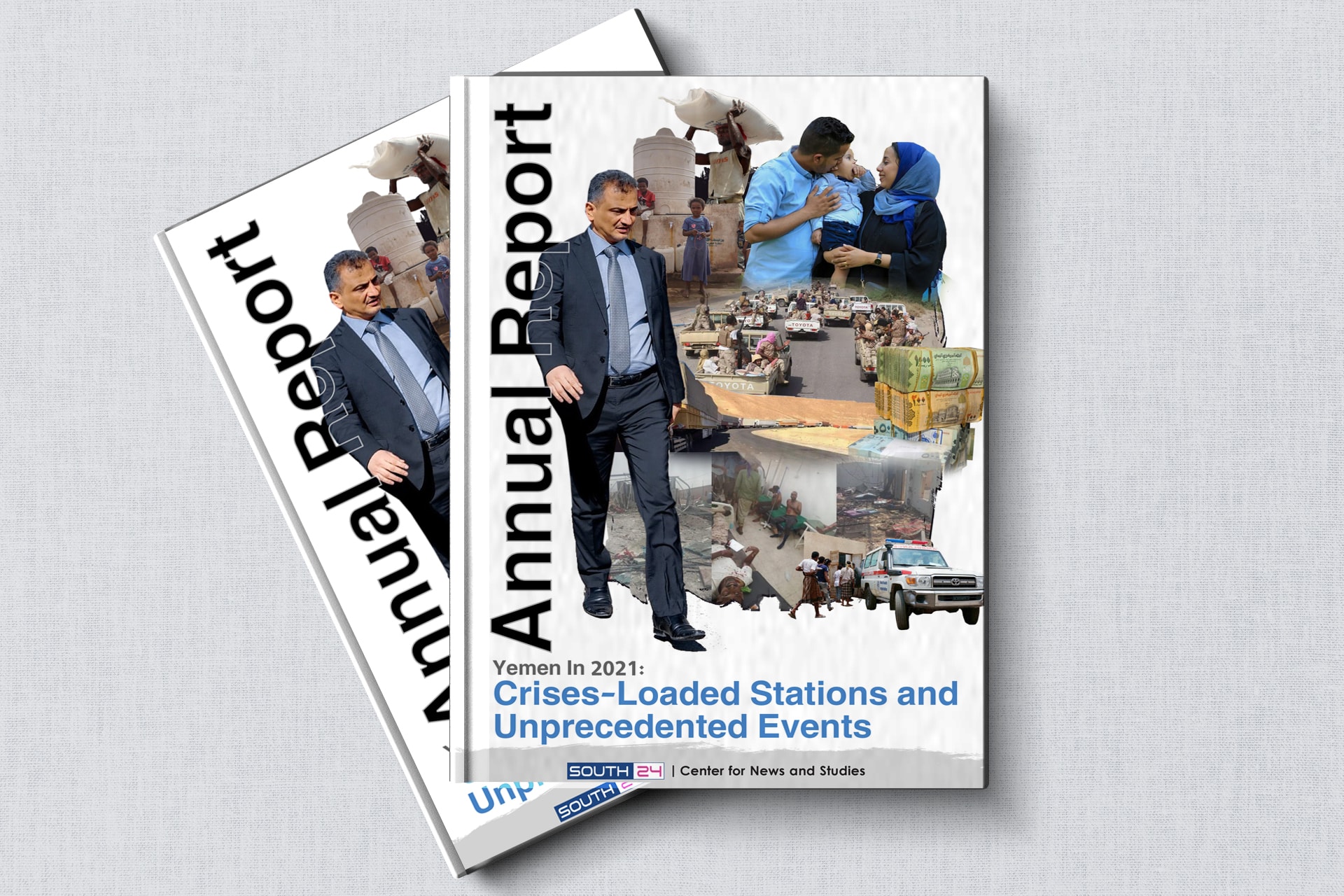
Last updated on: 28-12-2021 at 8 PM Aden Time

Zurich (South24)
On Tuesday, South24 for News and Studies published its annual report for the year 2021 in English which monitors the most prominent events Yemen has witnessed in North and South across the year. The report highlights the pace of political and economic developments and their ensuing catastrophic economic developments, as well as the continuous deterioration of the humanitarian and living conditions in the country that has entered a consecutive 7 years of the War.
The peace efforts have been hindered by the stubbornness of the Iran-backed Houthis. The Riyadh Agreement between the government and the STC has not achieved any practical progress, despite some positive indicators in the last week of 2021, with the increase in tension with the forces loyal to the Islamists in Shabwa and Wadi Hadramout as well as the escalation of the AQAP activity there.
Through The report, which is headed by major events that have important local, regional and international connections, South24 monitors the most prominent events in 2021 according to the chronological order from the oldest to the most recent within three main level.
The political and military level
It summarizes the most important political developments, which have been less sharp than the previous years, between the STC internationally-recognized Yemeni Government. It is related also to the Riyadh Agreement, signed by both parties more than 2 years ago and the formation of the Parity Government between South and North Yemen one year ago.
The level reviews the international community’s political and diplomatic efforts concurrently with the Swedish diplomat Hans Grundberg officially began his tenure as the new UN Special Envoy to Yemen on September 5th to succeed the British Martin Griffiths who sought, in parallel with the US Envoy to Yemen, Tim Linderking, to reach a cease-fire in Yemen through intensified negotiation tours with the Houthis that were host by Oman in the first quarter of 2021 but this has failed so far to achieve a notable outcome.
Moreover, the level addresses the military escalation events that changed the nature of war in the country due to the change of power balance on the ground, especially in North Yemen after the downfall of a number of governorates and cities into the hands of the Houthis who became close to seize Marib, the last bastion of the Yemeni Government in North Yemen, after they controlled 12 of its 14 districts. Additionally, the Houthis made the only military penetration in South Yemen since 2015 as they seized three of Shabwa’s districts without facing any resistance.
The level highlights also the most prominent “terrorist” events which targeted the Southern Security Forces by the AQAP as well as the bloody bomb attacks against local officials in the capital, Aden.
The economic level
2021 was the worst in both Southern and Northern areas including those run by the Government in Marib and Taiz, and the Houthi-controlled regions, as the unprecedented collapse in the price of the local currency “riyal” against foreign currencies created a catastrophic conditions over the year which led to a record food price hike amid a state of rage and large grassroot discontent amid international warnings of a looming famine.
This axis documents the collapse of the Yemeni riyal against foreign currencies starting from January 2021 when it was at the level of 730 against the US dollar while declined to 1700 in Mid December before witnessing a gradual improvement in conjunction with the appointment of a new Board of Directors to run the Central Bank in Aden. The currency collapse led to a huge price hike, especially the food commodities like wheat which didn’t exceed 15000 riyals per one sack (50 kg) at the beginning of the year, but it declined to 45000 riyals at its end. Furthermore, the fuel prices witnessed unprecedented increase during the year.
The level reviews the economic collapse’s impact at the grassroot level as it led to sporadic protests during the year in Aden, Hadramout, Taiz, Abyan and Shabwa. The year witnesses attempts to revive the economy through the Donors Conference in March and the different international aid along 2021.
The humanitarian level
This level monitors many humanitarian events and issues, and highlights the violations against civilians out of military areas of the conflict, and the violations against women and children.
Additionally, it highlights the violations against those who work in the press and media field across Yemen including assassination, killing, and arrest and restricting their freedom as well as violations against demonstrations. “South24” stresses that all those events and violations are caused by different disputing parties but to varying degrees, but the Houthis and the forces affiliated with the Yemeni government, especially in Shabwa, have been the most accused of standing behind them.
The report said: “With the end of 2021, it does not seem that stopping war in Yemen is looming as the battles escalated in Marib fronts Southeast of Sanaa, and the fronts of the Western Coast, Dhali and Shabwa. The Houthis intensified their aerial attacks against the Saudi territories and their rivals in South Yemen and Marib. On the other hand, The Saudi-led Coalition escalated targeting the Houthi locations which included the International Sanaa Airport for the first time in months. As it seems that Shabwa could witness a big incoming battle to secure South Yemen”.
- To read and download the full version of the report (here)
Previous article